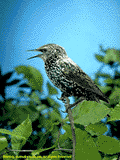Starling
 Starlings are a stout, medium sized bird (the glossy is slightly smaller, less robust) with a strong straight beak. Starlings have strong walking legs and feet. They are strong fliers. The glossy has quite a long tail, longer than its body length.
Starlings are a stout, medium sized bird (the glossy is slightly smaller, less robust) with a strong straight beak. Starlings have strong walking legs and feet. They are strong fliers. The glossy has quite a long tail, longer than its body length.
Coloration: Most starling species are metallic black, with iridescence showing green, blue and purple. Areas of plumage not overlaid with iridescence are velvety black. The superb starling has a breast bordered by a thin white band, and the low breast and belly are chestnut. The eye is pale yellow. The glossy starling is quite iridescent, and all black, with bright yellow eyes.
Starlings have a beak-probing action that characterizes all starling species worldwide. They insert their beaks into cracks, crevices, the ground, wherever, and pry. The shape of the open beak then allows the bird to peer down between the upper and lower mandibles into the created space in search for food.
Because of their ability to adapt to a variety of conditions, many species are on the increase, especially around human habitation. Because of their wide choice in foods they easily adapt to changes in their climates, and to introduction in strange places. Various species have become pests outside of their native land. The common or European starling is definitely a pest. Their presence pushes out native cavity nesters such as bluebirds and woodpeckers. Starlings begin their breeding cycle very early and have claim to available cavities before the other species, which usually migrate, even arrive in spring. Starlings usually do not dispossess cavities already occupied, so, if a diligent human can keep the starling nest material out of the cavity, a migratory species can claim it later.
Out of breeding season, starlings often congregate in large flocks (safety in numbers) for foraging. The swirling flocks can be seen along stretches of the highway in winter.
The superb starling alarm call is a loud whining, their song is a varied whistling. The glossy alarm is a loud raspy chirp, and the song is part musical and part reedy whistling.
Starlings are excellent mimics and have quite a variety of vocalizations including croaking, whistling, hissing and chattering. Mimics often run through their repertoire for their own amusement, and starlings often chortle quietly, almost inaudibly, to themselves. Other times the mimicked calls are quite loud. It is thought by some that mimicking other bird songs is an extension of singing one’s own species song. Singing is territorial announcement, meant to proclaim ownership of a given territory to other nearby males. If a bird can successfully mimic the territory song of other species it may well keep those males out also. This would possibly allow for increased food supplies by reducing both intra- and inter-species competition.
Because starlings are so gregarious, they do not usually defend large territories, but only actively defend their immediate nest hole. The flock will work together to keep interlopers and predators out, a behavior called mobbing.